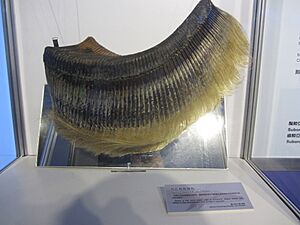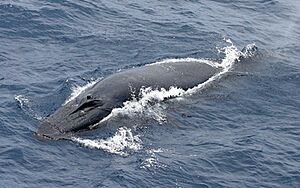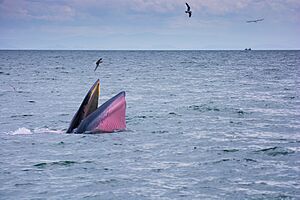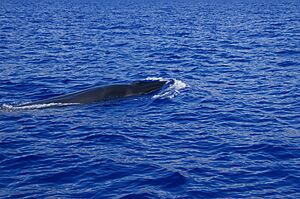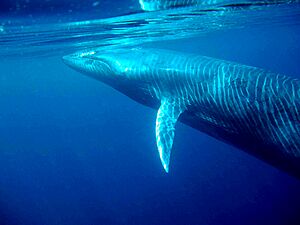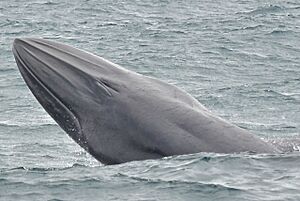Bryde's whale facts for kids
Quick facts for kids Bryde's whales |
|
|---|---|
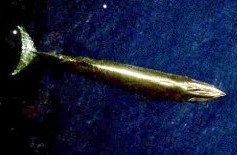 |
|
| Balaenoptera brydei | |
 |
|
| Balaenoptera edeni | |
| Conservation status | |
| Scientific classification |
|
| Unrecognized taxon (fix): | Bryde's whale complex |
| Species | |
|
|
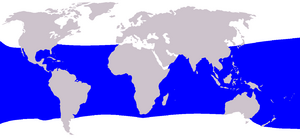 |
|
| Bryde's whale range | |
Bryde's whale (pronounced BROO-duhz), also known as the Bryde's whale complex, is a group of large whales called rorquals. Scientists think there might be three or even four different types of Bryde's whales. It's called a "complex" because it's tricky to tell exactly how many species there are, as more research is needed.
The most well-known type is the common Bryde's whale (Balaenoptera brydei). This one is larger and lives in warm and tropical oceans all over the world. Another type is the Sittang whale or Eden's whale (Balaenoptera edeni). It's smaller and might only live in the Indo-Pacific Ocean. There's also a smaller Bryde's whale that stays near the coast of southern Africa. Scientists are also studying another possible type in the Indo-Pacific that has a slightly different skull shape.
You might have heard of Omura's whale. It used to be considered a small type of Bryde's whale, but now scientists know it's a separate species. Similarly, Rice's whale, found only in the Gulf of Mexico, was once thought to be a Bryde's whale but was recognized as its own species in 2021.
Contents
How They Got Their Names
The name B. brydei comes from Johan Bryde. He was a Norwegian official in South Africa who helped set up the first modern whaling (whale hunting) station there. The name B. edeni comes from Sir Ashley Eden, who was a British official in Burma (now Myanmar). The name Sittang whale comes from the Sittaung River area, where the first Eden's whale specimen was found.
How Big Are They?
Bryde's whales are medium-sized rorquals. They are smaller than sei whales but bigger than Omura's whale and the small minke whales.
The largest Bryde's whale measured by Olsen in 1913 was a female about 14.95 m (49.0 ft) long, caught near Durban. Other long ones measured in Saldanha Bay, South Africa, included a female 15.51 m (50.9 ft) long and a male 14.56 m (47.8 ft) long. These were the "offshore" type, which live further out in the ocean.
When fully grown:
- The "coastal" form (living near the shore) in South Africa is about 13.1 m (43 ft) for males and 13.7 m (45 ft) for females.
- The "offshore" form in South Africa is about 13.7 m (45 ft) for males and 14.4 m (47 ft) for females.
- Coastal Bryde's whales near Japan are a bit smaller. Adult males are around 12.9 m (42 ft), and females are 13.3 m (44 ft).
An adult Bryde's whale can weigh between 12–25 metric tons (13–28 short tons). That's as much as several elephants!
What Do They Look Like?
Bryde's whales are baleen whales. This means they don't have teeth. Instead, they have two rows of baleen plates in their mouths, which they use to filter food from the water. They belong to the rorqual family, like blue whales and humpback whales. They have two blowholes on top of their head with a small splashguard in front.
Bryde's whales look a lot like sei whales.
- Shape: Bryde's whales are very long and slim, even more so than fin whales.
- Color: They are usually dark smoky grey on top and white on their belly. Sei whales are often a bluish-grey on top and might have a white patch on their throat. Some Bryde's whales in South Africa can also have a white throat patch.
- Head Ridges: This is a key difference! Bryde's whales have a straight snout with three ridges running along the top of their head, from the blowholes to the tip of the snout. Sei whales (and other rorquals) only have one ridge and a slightly curved snout.
- Jaws: Bryde's whales usually have dark grey lower jaws, while sei whales have lighter grey ones.
- Baleen Plates: Bryde's whales have 250–370 pairs of short, grey baleen plates. These plates have long, coarse bristles that are lighter grey or white. Sei whales have longer, black or dark grey baleen plates with shorter, curly, wool-like bristles.
Bryde's whales have 40 to 70 pleats (grooves) on their throat and belly. These pleats stretch to their navel or even past it. This allows their throat to expand a lot when they gulp water and food. Sei whales have shorter pleats. Both Bryde's and sei whales often have white or pink oval scars on their skin. These scars come from bites from cookie-cutter sharks.
Their dorsal fin (the fin on their back) is curved backwards and can be up to 46.25 cm (18.21 in) tall. It's usually located about two-thirds of the way down their back and often looks frayed or ragged. Their tail flukes (the two lobes of their tail) are broad with a notch in the middle. They rarely lift their flukes out of the water when diving. Their flippers are small and slender.
How Do Bryde's Whales Behave?

When a Bryde's whale breathes out at the surface, its blow (or spout) is tall and bushy, about 10–13 ft (3.0–4.0 m) high. Sometimes they even blow out air while they are still underwater.
Bryde's whales can seem a bit unpredictable compared to other baleen whales. They might come to the surface at odd times and suddenly change direction for reasons we don't always understand.
They are usually seen alone or in pairs. Sometimes, groups of up to 20 whales gather in areas where there is a lot of food. They tend to be more active at the water surface than sei whales, especially when they are near the coast.
Breathing and Diving
Bryde's whales usually take four to seven breaths at the surface before diving. They then stay underwater for about 5 to 15 minutes, but they can dive for as long as 20 minutes. They can dive deep, reaching depths of 292 metres (958 ft). When they dive, they don't usually lift their tail flukes out of the water.
Bryde's whales typically swim at speeds of 1–4 mph (1.6–6.4 km/h). However, they can swim much faster if needed, reaching speeds of 12–15 mph (19–24 km/h). They sometimes make short (0.4 seconds long), powerful, low-pitched sounds that sound a bit like a human moaning.
What Do They Eat?
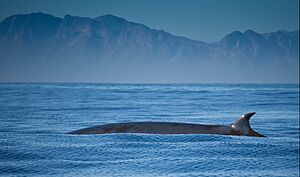
Bryde's whales are not picky eaters! Their diet includes a wide variety of fish, tiny shrimp-like animals called planktonic crustaceans (like krill), and cephalopods (like squid).
- In the western North Pacific: Bryde's whales studied by Japanese scientists (from 2000–2007) mainly ate Japanese anchovy (making up 52% of their diet) and different types of krill (36%). They also ate oceanic lightfish (about 3%) and mackerels (less than 2%). What they ate changed depending on where they were and the time of year. Near the coast, krill was their main food. Further offshore, Japanese anchovies were the most common prey.
- Off South Africa: The inshore (coastal) whales mostly ate fish like anchovies, maasbankers, and pilchards. The offshore whales (living further from land) mainly ate krill and deep-sea fish. One was even found with its stomach full of baby squid!
- In the Gulf of California: They mostly eat Pacific sardine and Pacific thread herring (about 88% of their diet), but also krill (11%). They have also been seen eating pelagic red crabs off Baja California.
- Other areas: In the Coral Sea, South Pacific, and Indian Ocean, they seem to mainly eat krill. Off Brazil, they have been seen eating sardines.
Bryde's whales use several clever ways to catch their food. These include:
- Skimming: Swimming along the surface with their mouth open.
- Lunging: Taking a big gulp of water and fish. Whales off the coast of Brazil sometimes add a twisting movement when they lunge.
- Bubble nets: Blowing bubbles to trap fish, especially in the Gulf of Tosa in Japan.
- Tread-water feeding or trap feeding: This is where the whale positions itself vertically in the water with its mouth open, waiting for fish to swim in. This has been seen in the Pacific and northern Indian Ocean, and is well-known in the northern Gulf of Thailand. Humpback whales also do this.
Reproduction
Bryde's whales are ready to have babies (sexually mature) when they are 8 to 11 years old. At that time, males near Japan are about 11.9 m (39 ft) long, and females are 12 m (39 ft).
Bryde's whales usually have a calf (baby whale) every other year. They can breed at any time of the year, but it's most common in the autumn. The mother whale is pregnant for about 12 months.
When a calf is born, it is about 11–13 ft (3.4–4.0 m) long and weighs around 1,000 kg (2,200 lb). Calves drink their mother's milk for 6 to 12 months.
Where Do Bryde's Whales Live?
Common Bryde's Whale (B. brydei)

The common Bryde's whale (B. brydei) lives in the Atlantic, Pacific, and Indian Oceans. They prefer warm waters, usually between the 40th parallel north and the 40th parallel south (lines of latitude on a globe). These waters are often very productive, meaning they have lots of food. The water temperature they like is about 61–72 °F (16–22 °C).
- North Pacific: They are found as far north as Honshu (Japan) in the west and southern California in the east. Sometimes, they wander even further north, up to Washington state in the USA. They live throughout the eastern tropical Pacific, including near Peru and Ecuador, but are usually not seen there from July to September. They have also been seen off Chile between 35°S and 37°S latitude.
- Southwestern Pacific: They live as far south as the North Island of New Zealand.
- Genetic Studies: Studies of whale bones and DNA have helped identify B. brydei. For example, a whale from Taiwan was identified as B. brydei. Whales caught in the open ocean of the western North Pacific and near the Bonin Islands (where a group lives year-round) were also B. brydei. Biopsy samples (small skin samples) from whales off Hawaii, Baja California, and the southern Gulf of California also matched B. brydei. Groups of Bryde's whales live year-round or part-time near Hawaii, the Northwestern Hawaiian Islands, and the Northern Mariana Islands.
- Sea of Japan: Bryde's whales are not commonly found in the central to northern parts of the Sea of Japan. One of the most northern sightings in recent times was a 5-metre (16 ft) whale found beached (washed ashore) at Nakhodka in 2011.
- Indian Ocean: B. brydei is found throughout the Indian Ocean, north of about 35°S latitude. Whales illegally caught by Soviet whalers in the 1960s in the northwest Indian Ocean, and those found in the Maldives, are thought to be B. brydei. Whales sometimes seen in the Red Sea might also be this type.
- North Atlantic: They have been seen as far north as Cape Hatteras (USA). They live throughout the wider Caribbean Sea. DNA studies showed that whales from Aruba were B. brydei and closely related to whales from Madeira and the offshore type from South Africa. They were first seen in the Azores in 2004. They are not usually found in the Mediterranean Sea.
- South Atlantic: They seem to live off the coast of Brazil all year round, in places like Rio de Janeiro and Ilha Grande. The inshore (coastal) Bryde's whales off South Africa also live there year-round, mainly between Cape Recife and Saldanha Bay. The larger offshore type migrates to warmer waters off West Africa in the winter. They are also regularly seen around Cape Verde.
Eden's Whale (B. edeni)
Eden's whale (B. edeni) was first identified from a specimen found on the coast of Myanmar in the Gulf of Martaban. Other specimens have been found along the coasts of the Bay of Bengal (Myanmar, Bangladesh, India), Thailand, Vietnam, Taiwan, and mainland China.
A population of whales found off southern and southwestern Japan in the East China Sea is also thought to be B. edeni. A whale stranded in Hong Kong and another rescued from a river in eastern Australia were found to be closely related to the original Eden's whale specimen and the East China Sea whales.
Small Bryde's whales (about 10.1 to 11.6 m (33 to 38 ft) long) seen near the Solomon Islands in 1993 might be B. edeni. Some of these whales were with calves that were 6.0 to 6.7 m (19.7 to 22.0 ft) long. It's not clear if some small whales (11.2 to 11.7 m (37 to 38 ft) long when adult) caught off Australia between 1958 and 1963 were B. edeni or Omura's whale.
Along the coasts of China, these whales were once thought to be common, especially in southern areas from Fujian and Guangdong Provinces to Hainan Island, and near Weizhou and Xieyang Islands.
How Many Bryde's Whales Are There?
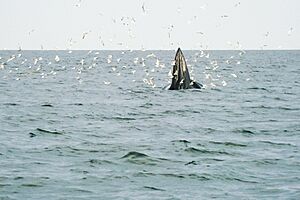
Scientists estimate there might be 90,000 to 100,000 Bryde's whales in the world. About two-thirds of them live in the Northern Hemisphere (the northern half of the Earth).
For conservation and management, the U.S. government divides its Bryde's whale population into three groups:
- The Eastern Tropical Pacific group (11,000–13,000 whales)
- The Hawaiian group (350–500 whales)
- An endangered group of about 100 whales in the Gulf of Mexico (these are now known as Rice's whales, a separate species).
In New Zealand, as of 2016, Bryde's whales are considered critically endangered. This means they are at very high risk of disappearing from there. Only about 200 are left in New Zealand waters.
Before 2006, there were only two confirmed sightings of Bryde's whales in the eastern North Pacific, north of Baja California (Mexico). One was in 1963 near La Jolla, California, and another in 1991 near Monterey Bay. Between 2006 and 2010, scientists saw Bryde's whales six more times in the Southern California Bight (the curved coastline of Southern California). Most of these sightings were of single whales. Another sighting happened off Dana Point, California, in 2009. In May 2015, a sad event occurred when a dead Bryde's whale washed ashore in Port McNeill Bay on Vancouver Island, British Columbia, Canada.
Overall, scientists don't have enough information to know for sure if the number of Bryde's whales is increasing or decreasing.
Protecting Bryde's Whales

The Eden's whale (Balaenoptera edeni) is listed as "Least Concern" by the International Union for the Conservation of Nature (IUCN). This means that, at the moment, it's not considered to be at high risk of extinction globally. The common Bryde's whale (Balaenoptera brydei) has not yet been officially assessed by the IUCN.
Bryde's whales are listed in Appendix I of CITES (Convention on International Trade in Endangered Species of Wild Fauna and Flora). This means that international trade of these whales or their parts for commercial reasons is banned.
They are also listed on Appendix II of the Convention on the Conservation of Migratory Species of Wild Animals. This means that countries are encouraged to work together to protect them. Bryde's whales are also covered by an agreement called the Pacific Cetaceans MOU, which aims to protect whales and dolphins in the Pacific Islands region.
Whaling: A Past Threat
In the past, Bryde's whales were not the main target for large commercial whaling ships. However, in the 1970s, as other larger whale species became rare due to overhunting, whalers started to hunt Bryde's whales more. Local hunters in places like Indonesia and the Philippines have also traditionally hunted them.
Modern whaling for Bryde's whales likely started at coastal stations in Japan in 1906 and continued until 1987. They were also hunted in the open ocean of the western North Pacific by Japanese (1971–1979) and Soviet (1966–1979) whaling fleets. Whaling also occurred from Taiwan (1976–1980), the Bonin Islands (near Japan, 1946–1952 and 1981–1987), and the Philippines (1983–1985).
It's estimated that over 20,000 Bryde's whales were caught in the western North Pacific between 1911 and 1987. It was later found that Japan had reported lower numbers of whales caught near the Bonin Islands between 1981 and 1987 than they actually took (they reported 2,659 but actually caught 4,162). Scientists in the mid-1990s thought that the Bryde's whale population in the western North Pacific might have dropped by almost half (49%) between 1911 and 1996 due to whaling.
A few Bryde's whales were also caught by Norwegian ships off Baja California (Mexico) between 1924 and 1929, and two were caught off central California in 1966.
About 5,542 Bryde's whales were caught off Peru between 1968 and 1983. An unknown number were also caught off Chile between 1932 and 1979. Over 2,000 were caught off Cape Province, South Africa, from 1911 to 1967. A pirate whaling ship called the Sierra caught many whales in the South Atlantic between 1969 and 1976; most of the 2,536 whales reported as sei whales are thought to have actually been Bryde's whales. Some Bryde's whales were also among the 5,000 "sei whales" caught off Brazil between 1948 and 1977.
In total, over 30,000 Bryde's whales were caught between 1911 and 1987. This includes over 1,400 taken by Soviet whalers in the Southern Hemisphere (the southern half of the Earth) from 1948 to 1973, though they only reported 19. The highest number of reported catches was in 1973–74 and 1974–75, when over 1,800 were caught each year.
Other Dangers and Incidents
Bryde's whales can face other threats too.
- Predators: Around 2011, a videographer filmed a group of about 20 orca (killer whales) hunting and killing a Bryde's whale in the Sea of Cortez (Gulf of California).
- Fishing Gear: So far, Bryde's whales have not been commonly reported as being caught or injured in fishing nets or lines.
- Ship Strikes: They are sometimes hit and killed or injured by ships.
- Noise Pollution: Loud noises in the ocean from ships and other human activities are a growing worry for all rorquals, as they use low-frequency sounds to communicate.
In the United States, these whales are protected by the Marine Mammal Protection Act of 1972.
In March 2019, a diver named Rainer Schimpf had a very surprising encounter off the coast of South Africa. He was photographing sharks near a large ball of fish when a Bryde's whale suddenly came up from below to feed. The whale opened its mouth wide to swallow the fish and accidentally engulfed the diver's upper body. The whale held him for a few moments. Mr. Schimpf held his breath, worried the whale might dive deep. However, the whale quickly spat him back out unharmed and swam away.
Sadly, there have been reports of tourists on jet skis bothering Bryde's whales off the coast of Phetchaburi Province in Thailand. It's important to give these amazing animals their space.
See also
 In Spanish: Rorcual de Bryde para niños
In Spanish: Rorcual de Bryde para niños
- List of cetaceans
- Marine biology



